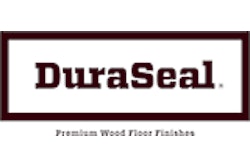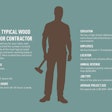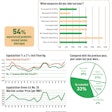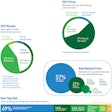

Uncertainty is the prevailing theme in the United States right now. Uncertainty regarding a war with Iraq, the strength of the economy and job security are daily stories in the news. Uncertainty about a another terrorist attack on U.S. soil is an underlying fear unthinkable to most people less than two years ago.
Amid this tumultuous environment, consumers who are worried about the economy and distrustful of their 401(k) plans are putting their money into something more stable than the stock market—construction. Some are taking advantage of amazingly low interest rates to invest in new homes;others are refinancing existing homes, helping push more cash into the economy. Thanks in part to the health of the building industry, the wood flooring industry has managed to maintain some momentum during these shaky economic times.
Two years ago, the economy seemed unstoppable. Anyone with a legitimate business seemed to be making money. Now, when people talk about their companies experiencing growth, they're quick to qualify it with a specific reason, whether it be a particularly successful product introduction, anew technology launch, or the enactment of stringent cost-control measures. Most are having to do business smarter to even approach the growth levels of just a few years ago.
"The industry is still in a growth mode, but nothing like what we were in two years ago," sums up John Mayers, director of sales and marketing for Upper Saddle River, N.J.-based DuraSeal.
Source material
The most pressing concern for wood flooring manufacturers today is lumber—where to get it and how to pay for it. A multitude of factors have combined to make obtaining lumber an increasingly difficult and expensive task.
The virtual collapse of the American furniture market, which lost business to low-cost Asian imports, created a proportionate decrease in the number of American sawmills. The remaining sawmills are struggling, finding no outlet for the higher grades of lumber that typically went into furniture production. Asa result, the cost of what they are producing only increases.
At the same time, flooring production in recent years has steadily increased,both from a continual influx of new flooring manufacturers and the increased production of existing manufacturers. That cycle is starting to take its toll. "We've had increased production across the board, either from new mills or people beefing up production,"says Jim Duke, director of sales at unfinished strip flooring producer Memphis Hardwood Flooring Co. in Memphis,Tenn. "The pricing of flooring is depressed, and some mills are starting to cut back production because of that situation … they're using up all their lumber."
Wet weather in the main lumber-producing regions in recent months has exacerbated the problem, causing some mills to decrease the number of shifts or lines running. Others have shut down entirely. "We cut back a shift to protect our raw material," says Marty Johnson,vice president and sales manager of Cumberland Lumber and Manufacturing in McMinnville, Tenn. "People can't get what they need every month. People continuing to run are catching up with what they have on the yard. Material in the kilns is wetter and wetter, and the dry times are longer." Some manufacturers even have tried to offset the problem by buying kiln-dried lumber, which Johnson says is a short-term solution. "You cannot buy kiln-dried material for any length of time to run a flooring plant and make any money; it's just too expensive," he says.
Although some strip manufacturers have the financial wherewithal to bear a slowdown in manufacturing, others,especially new companies or existing companies that took on debt to increase production capabilities, feel the pressure to create cash flow, cutting deals in the process.
Duke compares the current solid strip situation to what happened recently in the Canadian softwoods market. "To cope with the tariff, the Canadians upped their production like crazy to get the unit cost down. The result was more lumber, and it killed the price," he explains. "We're under that same kind of pressure. Mills want to keep the unit cost down by keeping production up, and it just keeps feeding the problem. It's not rocket science, but you don't feel very much in control," he adds.
Amazingly, new strip producers are still entering the market—there have been several new NOFMA-member mills in recent months. Some are expansions of sawmill companies, and therefore are able to avoid some raw material supply pressures. The new companies appear to fill a need, ascertain commodity products are in short supply.
"We're looking for new mills all the time … if you're trying to find 3 1/4 common white oak right now, they'll tell you to wait four to six weeks. It's just really tight," says John Troendle, president of distributor Crescent Hardwood Supply in New Orleans. "Lots of these companies tell you that you can only have so many pallets a month." Many producers find that pushing their strip supply into prefinished products is wiser, he explains. "The object of the game is to get the most for your dollar … if it's not profitable to sell unfinished, they have to do it in prefinished, and they aren't having any problems selling prefinished flooring."
Major Canadian producer Lauzon Ltd. in Papineauville, Quebec, has taken steps to address the supply problem. The company now owns four sawmills,having bought Canada's largest sawmill earlier this year. The purchases help the company secure coveted raw materials at a crucial time. "Raw materials will be the critical factor in the next five years with regards to hardwood flooring manufacturing," says Robert Coveney, vice president of sales and marketing at Lauzon, adding that costs must be passed along. "We'll be experiencing good price increases in the coming year from all hardwood flooring manufacturers, because the cost of raw material will be increasing."
Unfinished strip prices already have begun to creep up from rock-bottom prices experienced during the last two years. That upward movement should continue. "Prices will rebound," says Neil Poland, president of Johnson City,Tenn.-based manufacturer Mullican Flooring. "There will be some increase over the next six months due to production being taken off the market."
Incremental increases may not be enough to offset the current challenges for some manufacturers, however. "In the long term, we will continue to face limited raw materials,and any significant decrease in demand will really be tough … the stronger companies will make it," Duke says.
Some of those stronger companies are the ones who expanded beyond the commodity strip business. "Fortunately,we diversified into specialty products four years ago," Poland says. "The unfinished strip market is a very poor business to be in right now on its own."
Making the switch
Expanding into prefinished flooring has been a popular venture in recent years. The list is long of unfinished strip manufacturers now producing factory-finished flooring, or even switching to it as their core business. "Everybody and their brother is getting a prefinish line," Johnson says. "To some extent, it's already getting to be like the unfinished market; it's a commodity."
U.S. strip producers aren't the only ones getting in on the market. The number of Canadian factory-finished flooring manufacturers also is steadily increasing, and much of the production is aimed at the lucrative U.S. market. "The dealers in the United States make a substantially larger margin than retailers in Canada … when those Canadian products go south of the border, there's a major premium put on them, and that premium does not exist in Canada," says Tom Gormley, senior vice president at Delson, Quebec-based Goodfellow.
Within Canada, competition is fierce. Most wood flooring manufacturers bypass distribution, instead selling direct to carefully selected, dominant dealers. "The kind of ferocious environment we have here in Canada lends us to be extremely competitive when we take our offering and point it down south," Gormley adds.
The predominance of prefinished flooring manufacturers, especially in eastern Canada, has helped factory-finished flooring take a leading role over site-finished flooring in most Canadian markets. Vast improvements in factory finished floors have helped the floors gain an edge in many markets in the United States, as well. The advent of UV cured aluminum oxide as a standard finish was a major step, and improvements in the finish have stepped up the pace of prefinished flooring's popularity. "Prefinished floors are much better due to the enhancements by major finish manufacturers … whereby the aluminum-oxide finish is much smoother, cleaner and clearer than it was four or five years ago," Poland says.
Troendle agrees. He sees factory-finished floors taking increasing market share in his area. "Definitely in the last five years there's been a big increase in the performance of prefinished floors. They've gone from no performance to offering 25-year warranties, ceramic finish and acrylic UV finish," he says. He adds that today's aluminum-oxide floors also can be recoated without problems, eliminating a concern regarding the earlier generation of aluminum oxide floors.
The drastically lengthened factory-finished floor warranties have grabbed consumers' attention, manufacturers say. Consumers have become more confident in the products, commonly using them in higher-traffic areas such as kitchens. As expectations increase, the bar has been raised for all products, says Harris-Tarkett's president, Jim Morando. "If you're in the business today, the quality expectations are being ratcheted up, so you really have to make sure you're investing in your equipment to improve your tolerances,milling, finish and so forth. You also have to offer more variety so you don't get lost in the plethora of products out there," he says.
Running the Gamut
Today's choosy consumers expect products they perceive to be unique. Factory-finished floors in myriad domestic and exotic species are available, and wide-plank floors are popular. Custom look finishes such as distressed floors and hand-scraped floors are hot trends.
"Color and style are becoming more important in hardwood flooring. Ten years ago, we used to have three colors: light oak, medium oak and dark oak,"says Mike Weise, vice president of sales at Wausau, Wis.-based Award Hardwood Floors. "There are more species, more color and more styles than we've ever had for the consumer to choose from,and quality continues to improve, so the consumer really gets value."
As the manufacturers proliferate, flooring giant Armstrong, with its Robbins, Bruce and Hartco brands, sees itself positioned to offer consumers what they want. "In a situation like this,we have to leverage our scale, but we also have to act like a small company,being fast when necessary as we focus on our customers … we've got to have great products in all three of these brands in the right places at the right times," says Joe Guarino, marketing channel manager for retail at Lancaster, Pa.-based Armstrong Floor Products. Guarino says the company is focusing on differentiated products in all three brands to improve the company's product mix and competitive advantage. A goal is to create a different focus for each brand, he says. "Whereas a lot of the same products were across the Robbins, Hartco and Bruce brands for years,we're now targeting different consumers with different brands," he says.
Companies need to not only keep up with consumer trends, but discover new technologies. Continued upgrades in finishes is one focus. "I think more and more companies will strive to position themselves with these new innovations to maximize product differentiation," Lauzon's Coveney says. "We're certainly working hard on that; you'll see more technological advancements in the next five years."
Some floating hardwood floor manufacturers already are touting glueless application systems. Coveney sees that as an inevitable trend. "The glueless applications are coming strongly from Europe; I think it's only a matter of time before it hits North America full speed ahead … glueless installation in the engineered floating product will become a major factor," he says. Award, for one,has switched all of its products to a glueless installation system.
The intense competition among manufacturers in the market can help the overall business succeed, some manufacturers say. "Competition is what grows the hardwood business overall,and you can only do that by making inroads into other business segments, whether it's carpet, vinyl or laminate," says Danville, Va.-based Columbia Flooring's director of business development, Steve Bunch. "The only way we can continue to grow our business against them is with design and styling … If we can get a consumer to walk into a floor covering store and excite them about our product, that's what's going to grow our business."
Market share battles
Almost everyone in the industry agrees that the market for both traditional solid unfinished strip and prefinished hardwood flooring is growing, with prefinished flooring outpacing its predecessor by a healthy margin. Observers generally agree that prefinished floors already account for a majority of the remodeling segment, and that the new home market is still weighted in favor of unfinished products, but that's changing. A general shift in consumer perceptions contributes to the trend.
"There's definitely been a transference—before, unfinished was perceived as being better, and today you could arguably say the quality of prefinished flooring has surpassed the unfinished floor," Gormley says. "In terms of durability, it's hard to demonstrate that an unfinished floor will perform as well as these new floors."
Factory-finished floors also are receiving a boost from a growing number of relatively new supporters—the general floor covering retailer who previously sold only flooring such as tile,carpet and vinyl. Floor covering giants Mohawk and Shaw entering the market two years ago accelerated that trend(for more on Mohawk and Shaw, see the sidebar "Here to stay" on page 28). "The independent retailer is gaining ground against traditional wood floor finishing guys," Bunch says. "They have confidence in selling hardwood floors because prefinished floors today offer so many advantages over job-site finishes; they have the confidence to go head-to-head against any sand-and-finish guy today."
Of course, a large segment of the industry, not least of which are the finish manufacturers, take issue with the claim that factory-finished floors are now superior to a job-site finished floor. "There are 25,000 contractors who make a living sanding floors. They drive the business harder than people selling carpet and vinyl," says Ron Peden, CEO of sanding and finishing products manufacturer BonaKemi USA, based in Aurora, Colo. "I really believe those 25,000 contractors are going to continue to have a stronghold and influence on strip flooring."
Although some in the industry see alack of skilled labor as a contributing factor to the decline of unfinished flooring in the future, many markets today have a healthy supply of contractors. Preferences between prefinished and unfinished flooring are largely regional, and unfinished products are still a strong favorite in many areas.
"Even though prefinished has picked up over the last few years, we're not anywhere near the prefinished levels that a lot of the country's doing," says Matthew Cook, president of distributor Geysir Hardwood Floors in Mamaroneck, N.Y. "It's probably because labor is cheap here, and there's lots of it. There's no shortage of people here willing to install, sand and finish floors, and prices are competitive to the point that it takes much less money to have a floor finished on the job site."
Between the efforts of manufacturers and industry associations, contractors today are better educated than ever before. "Overall, the industry's done a better job of training at the contractor level," says Dura Seal's Mayers. "The NWFA's done an outstanding job of adapting the schools."
To compete in the future wood flooring market, contractors will need to take advantage of education more than ever. "The industry will be more sophisticated, because consumers are smarter than they've ever been, and that breeds sophistication. Even someone in the back hills has a computer and can do research," says Mike Sundell, president at Des Moines, Iowa-based Basic Coatings. "Some poor contractor goes in to sell them something he's been using for20 years, and the homeowner starts questioning him, 'Why are you using this? The Internet says this is no good.'The contractor's comfort zones are being shaken."
BonaKemi's Peden agrees that contractors will have to step up their professionalism and knowledge to be successful. "The contractors have to keep up with the new areas and technologies, and they're going to have to provide a service in a timely and professional manner," he says. He points to Bona's dustless sanding system as an example of a newer technology savvy contractors can use to tap new customers, such as those who have been tolerating their worn-out floors because they didn't want the mess and hassle associated with refinishing.
Contractors also will prosper by focusing on higher-end work. That's one area where the custom capabilities of unfinished flooring still beats out prefinished floors hands-down. "The prefinished market takes over in homes $300,000 or less," says Janet Sullivan, manager of the flooring division for Baltimore, Md. based finish manufacturer Lenmar. "When you get into the million-dollar homes, it's still strip wood flooring, and they may use specialty exotic woods or something like that." Regardless of whether the floors are prefinished or unfinished, finish manufacturers see a win-win situation. "Our take is that prefinished floors end up getting refinished over the years, so go ahead and keep putting them in," she adds.
Still going strong
Although prefinished floors eventually provide finish manufacturers with more business, the finish companies also have a strong vested interest in fostering the success of their core customer base—the traditional sand-and-finish contractor. To that end, the finish manufacturers say their finishes continue to improve in durability, and the companies are always looking for the next step in useful finishing technology.
"The finishing contractor is not paid a whole lot more than he was 10 to 15 years ago, but labor and product costs rise," says Dura Seal's Mayers. "We need to challenge ourselves to continue to bring products to market that bring value to the consumer but also somehow increase the contractor's productivity."
"We've got the resources in our R&D department; we're always looking for new products, things that will be friendlier to the contractor and the end user," BonaKemi's Peden concurs. "That's really our focus: How can we help the contractor do his job better and faster so he can make more money?"
As finish companies develop the next generation of user-friendly finishes, one uncertainty has been removed from the picture—the potential for a national VOC law. A few years ago, many thought a restrictive national law would change the finish market, with waterborne finish drastically increasing its market share. Instead, solvent-based finish manufacturers now pay an "exceedance fee," and business continues mostly as usual. Waterbornes have increased in use, but not to the degree expected. "You still see most solvent-based finish manufacturers introducing waterbornes; you can't stick your head in the sand," says Julie Russell, marketing manager for Seattle, Wash.-based Glitsa American. "Waterbornes are still the way things are going, but it's not happening as fast as everyone thought it would."
Crescent's Troendle points to high performance waterborne commercial finishes as an example of how much finish technology has improved recently. "For years, wood was sold for beauty. Now it's being sold for beauty and performance and retail appeal. It's not something that you would have put in a retail setting five years ago; the finish would wear off in a month and look really bad. Today, you look at those floors, and they hold up very well," he says.
In the near future, Basic's Sundell envisions a market that has a finish specialized for every type of application. "There used to be about a 20-year cycle for new technology. It took that long to develop something, prove it and get it out there before something else came along," he explains. "With today's technology, the ability to test faster, and the knowledge levels, that cycle is now about five years."
In the meantime, finish manufacturers are keeping a close eye on the competition. Just as the wood flooring market has been flooded with new producers, the finish market likewise is saturated. Some companies are new; others already are firmly entrenched in Europe or elsewhere and are seeking to penetrate the North American market.
In the increasingly competitive atmosphere, companies must constantly seek new niches and markets. "We're broadening out what we're looking at and where we're going to look at it," Sundell says. "We might have to change tactics; we might have to take the game to Europe since they're coming here. We can play it there just as well as they can here—or better. We're going to have to start fighting back."
Across the globe
Increasing "globalization" applies to finishes and every other product category in the industry, but none more than wood flooring.
"As manufacturers of flooring, we're concerned about China," says Cumberland's Johnson, who points out the country's free trade status. "We feel they don't have enough duties and tariffs imposed on what they're bringing into this country. China has never heard of EPA, OSHA,workers comp, or medical insurance, and they pay workers a buck a day—we're not on the same playing field. There's noway we can compete with that country."
Many U.S.- or Canadian-based wood flooring manufacturers are essentially private-labeling products from more competitive manufacturing markets. The global economy is a fact of life, and they're prepared to compete.
"One of our advantages is that we are part of a global company," says Columbia's Bunch. "We have a good understanding of Asia and other parts of the world. The bottom line is you have to be able to compete and be able to continue to offer a value, because you can't control or stop competition. So, our attitude is that you need to have strategies that enable you to compete and continue to grow, with the expectation that they'll be there and continue to be there."
Award's Weise looks to the laminate market for an example of a likely situation in the future of the wood flooring industry. "You'll have people internationally coming in and trying to establish a presence, and if they have a difficult time, they may dwindle away. In the United States today, you have six or seven laminate manufacturers," he says. "They went through this growth cycle where there were numerous people coming into the market; the main stayers have been able to maintain their market share based on distribution and product performance."
Joining forces
Streamlining of the industry in the next few years is a given, according to most industry observers. "Eventually, in any industry there's always consolidation as the industry grows, and the hardwood business won't be any different," Bunch says. "You'll continue to see strategic alliances and acquisitions; that's just the nature of a business growing as successfully as the hardwood flooring business."
"I think you're going to see two types of players," Weise says. "There will be niche people who focus on specific areas, and then you'll see the big players get bigger and continue to grow. It's going to be hard for somebody to try to be in the middle."
Cumberland's Johnson sees smaller,successful companies, such as his, as appealing targets for the bigger players in the industry. "I think what we'll see in the future is a decrease in smaller people like us," he says. "People like us will probably be gobbled up by bigger people like Bruce or Harris-Tarkett."
The current pricing woes will only accelerate the process, Morando says. "With the price structure being where it is today, there has to be some consolidation; I don't think everyone is going to successfully overcome the challenges of double-digit increases in raw materials and low single-digit increases, if anything,on the selling side. I think some people who were just getting by are now going to be looking for alignments or will have to partner with someone," he says.
That same concept applies to all product categories in the industry, not just wood flooring. The potential exists across all product categories and company types. "With more competition,there will be some consolidation and some elimination," Peden says. "It gets back to the same old thing—the stronger companies survive because they have the resources and marketing, things that continue to be in front of the contractor on a daily basis … So there definitely will be some fallout."
That situation can leave distributors in a bind. Who they partner with becomes more critical in such an environment. "The big question mark is the economy—who's going to be able to ride it out and do well from a financial standpoint?" says Blake Blythe, president at Louisville, Ky. based Lanham Hardwood Co. "We have aligned ourselves with manufacturers wefeel very comfortable with and have done business with for many years."
In an industry that's still personal and informal in many ways, larger companies breeding a more corporate environment could be a difficult adjustment. "Sometimes when that happens, what suffers is the personal service and friendliness that the contractor and distributor like to see," Sundell says. "This has been a very' down-home' business, and when you getaway from that and into big corporate business, people suffer."
Lenmar's Sullivan is surprised that the large corporate paint companies such as Benjamin Moore haven't tried to penetrate the wood flooring coatings business. "Five years from now, I can see them trying to break into the market; the market will be bigger and more known. Our products are very similar to what paint companies make every day," she says.
Johnson thinks that the future of wood flooring will largely depend on the biggest corporate players, including Shaw and Mohawk. "How much of this business do the big boys want? I don't know," he says. "The little guys like us can't dictate anything on the market." The biggest company in the wood flooring industry,Armstrong, which includes the Bruce, Hartco and Robbins brands, itself is a question mark. Industry speculation has been rampant regarding what will happen with the company when it emerges from bankruptcy; most feel it will be sold within the next year to 18 months.
Looking ahead
Industry players keep an eye on all these larger issues as they formulate their plan for the rest of 2003. Despite the spectre of war with Iraq and a shaky economy,many say they are "cautiously optimistic"for the coming year.
"In 2003, our first quarter looks like it will track ahead of last year, but with all the uncertainty of what's going to happen,I think there's going to be a softening until those issues are resolved," Morando says.
"It is an interesting market; there are lots of changes going on. We put the money in R&D and marketing and hope the economy doesn't fall out from under us. There is no crystal ball," Sundell says, adding that Basic has "plans A, B and C"depending on what happens with the economy.
At Wilmington, N.C.-based PortaNails, President Jerry Coleman Jr. forecasts "continued growth for our industry, even though the economy will remain sluggish." He also looks for remodeling, especially do-it-yourself markets, to be strong.
With recent housing starts continuing at healthy levels (see chart on page 44),the wood flooring industry should remain successful for the immediate future. What happens after that is speculation, but confidence remains high that wood flooring's share of the market will remain healthy and continue to grow. Despite what happens with the war, the stock market or housing starts, wood flooring's standing as a high-end, stylish,renewable and versatile hard surface is secure for the future.
Serving a purpose
In recent years, there has been increased discussion about the role of the distributor in the wood flooring industry. Will distributors continue to serve a purpose, or will increased market pressures make them obsolete? As the industry evolves, distributors have felt the threat of big box stores such as Home Depot and Lowe's, as well as new types of competition, such as Mohawk and Shaw, which essentially serve as huge wood flooring distributors (see sidebar "Here to stay" on page 28). As the debate continues, the wood flooring distributor appears far from obsolete.
While the business climate has become tougher, the wood flooring distributor hasn't stood by idly, says Neil Poland, president of Mullican Flooring in Johnson City, Tenn. "Our distributors have been forced to improve themselves every year due to the competitive environment. That may mean adding salespeople, having more complex marketing strategies and promotions, or continuing to do a better job with education," he says. "The hardwood flooring distributor has been pretty resilient." Julie Russell, marketing manager at Glitsa American in Seattle, agrees. "The distribution channel is very much the same," she says. If anything, she says, "they've become more specialized to service their customers without a grocery store type of mentality."
For the St. Paul, Minn.-based Construction and Home Improvements Markets Division at 3M, "Distributors are the key to our success," says Galen Fitzel, technical service specialist. "We fully expect to have the same relationships, if not better, with our distributors five years from now."
As major manufacturers have continued to foster relationships with their distributors, many distributors have been reluctant to take on products from upstart manufacturers. "The big industry players have maintained their relationships with distributors," says Matthew Cook, president at distributor Geysir Hardwood Floors in Mamaroneck, N.Y. "A lot of these upstarts from Asia and Canada aren't being accepted, because we already have relationships built." Many of the new manufacturers offer a "me-too" type of product, creating little incentive for distributors to take on another line.
With such a wide variety of products and manufacturers in the market, it's becoming more important for distributors to find a means to differentiate themselves and their products to their contractor customers. There are many specific strategies to do that, but it all comes down to service. "We're making sure we're focused on doing the best job we can do for our customers and looking for better ways to service them," says Blake Blythe, president of Louisville, Ky.-based distributor Lanham Hardwood Co. "In addition to that, we're educating our customers on the benefits of the products we're carrying."
For Robert Coveney, vice president of sales and marketing at manufacturer Lauzon Ltd., based in Papineauville, Quebec, the mentality of the distributor is more important than the type of distributor, whether it be hardwood-specific or a general floor covering outlet. His products are high-end, and a distributor's attitude must be appropriate to his high-end products, he says. "For us, it's very important that our distributors have the same philosophical approach that we have—the knowledge of valueadded selling and the commitment to it," he says. "It's more of a detailed sales process rather than just logistical distribution."
Some distributors are positioning themselves in that valueadded niche as they try to secure their future success. At Crescent Hardwood Supply in New Orleans, President John Troendle categorizes his business as a "specialty" distributor. "As part of that value-added process, we're selling species from every continent except Antarctica," he says. "Five years ago, if you would have told me our dollars in Australian cypress would be where they are today, I would have said, 'Yeah, right.'"
Aurora, Colo.-based BonaKemi CEO Ron Peden agrees that distributors need to choose their strategies carefully. "Distributors will have to partner with key manufacturers who have quality products, and they'll have to give that value-added service they're charging for—the delivery service, product knowledge, claims handling," he says. "I think the distributors have to realize they can't be all things to all people … they need to choose who they want to be in business with."
One of the biggest threats to the smaller distributors are their fellow distributors. "Large distributors are making moves to become bigger and more widespread—a Wal-Mart kind of thing," says Janet Sullivan, manager of the flooring division for Baltimore, Md.-based Lenmar. "Just on the East Coast, I've seen them buying out smaller distributorships and opening up in markets where they've never been before."
Traditional hardwood flooring distributors also see increased competition from another angle. "We find ourselves competing more and more against distributors that carry a wider range of flooring, like carpet and laminate," Blythe says.
Coveney concurs. "We're getting more business from the type of distributor that is more and more the generalist," he says. "The conventional vinyl and sometimes carpet distributors are moving into the wood portion of it, and these people are extremely well versed in distribution." With Shaw and Mohawk in the wood flooring business, floor covering distributors are under increasing pressure to compete, he adds.
At Armstrong, "We're definitely committed to independent distribution," says Joe Guarino, marketing channel manager for retail at Lancaster, Pa.-based Armstrong Floor Products. "That being said, we're also convinced that one size doesn't fit all relative to a footprint of distribution in any particular marketplace." Doing business in varied channels helps protect the company against volatility in particular segments, he explains.
One distribution channel that has received lots of attention in recent years is the big box, especially as the stores appeared to position themselves to snatch more professional business, including wood flooring contractors. So far, however, the fears they created have been largely unfounded.
"The big boxes were a bigger scare a few years back," says Alan Greer, president of hardwood distributor Greer Co., based in Memphis, Tenn. "Now we look at them more as a customer as opposed to competition. We're selling to them on an individual store basis … we have a few of those who are pretty large customers now."
The reasons contractors prefer traditional distributors are pretty clear, he says. "They want to get in and get out and not take 30 minutes to get loaded up," he says. "If somebody comes in here, it takes 10 minutes to get in and out. There, you're trying to get around all the people loading up fencing and 2x4s and all that; it takes awhile," he explains.
In New York, Cook doesn't see much effect from the mega home centers, either. "We have two Home Depots and one Home Expo within 10 miles of our location; it hasn't hurt our business very much," he says. "The trades don't want to stand in line at Home Depot and buy something that was stored outside by mistake."
Mike Weise, vice president of sales at Wausau, Wis.-based Award Hardwood Floors, sees the home centers benefiting the industry. "The home center market has created more interest for the consumer looking for wood flooring at the lower price points," he says. "I think there are two separate consumers out there, with minimal crossover in the middle. You have the consumer who says, 'I want to do this myself, because I'll save some money' … and the other consumer says, 'I don't have the time, therefore I need to go somewhere where I have a lot of confidence that the product is perfect and installation is perfect.' You'll always have middle- to high-end consumers purchasing from floor covering retailers," he says.
In Canada, where prefinished wood flooring and the do-ityourself market are dominant, huge home centers have made an impact. "Big-box stores have taken massive market share in floor covering in general," says Tom Gormley, senior vice president at Delson, Quebec-based Goodfellow Inc. "They've certainly taken a lot away from the independent lumber dealer, and they're getting better at selling consumers. These dealers are very, very aggressive with their pricing and tend to set the low price in the market," he says.
In the United States, the industry still keeps a wary eye on the activities of the big boxes. Just last fall, Home Depot purchased three large floor contracting companies, which Home Depot said would make it the "largest turnkey supplier of flooring to the residential construction market." "We haven't seen any effect yet, but we're definitely going to keep our eyes open to see if there is an effect," Lenmar's Sullivan says. In the meantime, wood flooring distributors remain necessary, as long as they are well-run and service-oriented. "I still don't see in the short term future where distributors are going to be a dying breed … they still serve a viable purpose," says John Mayers, director of sales and marketing at Dura Seal. —K.M.W.
Here to stay
Two years ago, carpet giants Mohawk Industries and Shaw Industries both announced they were entering the wood flooring business. Today, their long-term effect on the industry is still ambiguous, but their presence as national distributors of wood flooring is firmly established, having taken advantage of their expansive distribution systems and dealer networks to roll out their wood flooring brands. Both companies report that the introductions of their wood flooring lines have been a success, even though they were introduced not long before a booming economy slowed significantly.
"We've continued to show pretty impressive growth; where we are today is fairly close to where we had projected," says David Wilkerson, vice president of marketing for the hard surfaces division at Shaw. At Mohawk, "We had a successful year in hardwood; we basically doubled our business from the previous year," says Bob Weseman, vice president of hard surfaces at Mohawk. "The reception of our new products for 2003 was overwhelmingly positive."
Both companies are armed with numerous product offerings that feature the latest wood flooring trends, including plank products in a variety of domestic and exotic species. Both have found glueless technology to be a hit with their dealers. Mohawk's DuraLoc LS product has been "very favorably received," Weseman says, while Shaw's Esteem product line, introduced at Surfaces last year, has become the company's bestselling product, Wilkerson says.
There has been a learning curve for both Shaw and its dealers, Wilkerson says, but the prefinished products helped them make the adjustment, and the glueless technology makes it even easier. "The prefinished floor does not require the same level of experience to install as a site-finish floor, so that makes it a lot easier for them to get in the business," Wilkerson says. "Now that there are glueless options in hardwood, you can truly let laminate crews get involved with hardwood, because it's the same basic procedures." The companies' successful introductions have been noticed by colleagues in the industry. "They've had a very successful entry; they've done a good job taking dealers who spent their lives selling carpet very successfully and getting them to focus on hard surfaces," says Steve Bunch, director of business development at Danville, Va.-based Columbia Flooring.
From Armstrong's perspective, however, "They haven't affected our business," says Joe Guarino, marketing channel manager for retail at Lancaster, Pa.-based Armstrong Floor Products. Armstrong is focused on its current product launches—the company's most ever—and not on what Guarino refers to as the "sort-of niche approach" Shaw and Mohawk have taken.
Although the companies are two more powerful competitors in a crowded industry, their visibility and financial fortitude can be positives for the industry in general. "I think the one thing they brought to the market is more awareness of prefinished wood, and also more awareness of wood in general," says Ron Peden, CEO of Aurora, Colo.-based BonaKemi USA. "All those retail locations all over the country now support wood. Ten years ago, 50 percent of those retail stores didn't even have wood flooring displays." Wood flooring has proved to be just as competitive or more so than the other floor covering categories the companies handle. Because customers already perceive any hardwood flooring to be high-quality floor covering, upselling can be challenging.
"There are upgrade opportunities, but there is a big part of the business dominated by starting-point products," Wilkerson says. "On 21⁄4-inch solid, there's not as much upgrading as seems to take place with tile or carpet. The average consumer may not see a reason to go into something more expensive when they're already getting something that in their minds is a quality product," he explains. John Troendle at Crescent Hardwood Supply in New Orleans has already seen an effect from both companies' presence in the market. "Shaw and Mohawk are getting very big into tying up these retail floor covering stores on what we call the bread and butter items, such as 3⁄8-by-3-inch engineered flooring, he says.
The companies' size, strength and brand awareness work to their favor. Mohawk's key strategies for growth include leveraging the Mohawk brand, sourcing products from around the world and taking advantage of its existing, extensive distribution network, Weseman says. In addition, its product offerings are region-specific. "We offer the colors and construction method more specific to the market—what the need is, rather than having one product line for the whole country," he explains.
Both companies clearly intend to grow their hardwood business. Weseman says that Mohawk's goal to is "to have a leading position in all hard surfaces categories." At Shaw, Wilkerson says expansion plans are "tied to just growing our product line and customer base." The company has looked at the possibilities of building hardwood manufacturing plants or acquisitions, but it hasn't "made a firm decision on what we will do," he says.
How aggressively both companies pursue expansion plans will be interesting to see. Right now, they appear to have affected floor covering distributors the most. As they expand, their influence certainly will spread. Without a doubt, both are here to stay. —K.M.W.
Finding the Way
In January, Hardwood Floors surveyed distributors and contractors to find out how their businesses are doing and what they're doing. Here are the results from our exclusive survey:
Distributors' Business in 2002...

In 2001...
• 50 percent of distributors indicated that business increased
• 22 percent stayed the same
• 28 percent decreased
Contractors'Business in 2003...

In 2001...
• 53 percent of contractors indicated that business increased
• 30 percent stayed the same
• 17 percent decreased
Finish Sold by Distributors

In 2001, distributors said...
• 52% oil-modified
• 37% water-based
• 8% moisture cure
• 3% conversion varnish
• <1% wax
Finish Sold by Contractors

In 2001, contractors said...
• 70% oil-modified
• 21% water-based
• 5% conversion varnish
• 3% moisture cure
• 1% wax
Species Sold by Distributors

The distributor numbers in 2001 were....
• 47% red oak
• 25% white oak
• 9% maple
• 4% Brazilian cherry
• 3% other domestics (ash, birch, beech)
• 2% American cherry
• 2% pine
• 8% other exotic species
Species Sold by Contractors

The contractor numbers in 2001 were....
• 55% red oak
• 25% white oak
• 9% maple
• 3% Brazilian cherry
• 2% pine
• 2% other exotic species
• 1% other domestics (cherry, ash, birch, beech)
*Other domestic species: ash, birch, beech.
Distributors* are selling...

Distributor numbers in 2001 were...
• 55% unfinished solid
• 28% prefinished solid
• 15% prefinished engineered
• 2% unfinished engineered
*93% of distributor respondents specialized inwood flooring, while 7% were general floor covering distributors.
Contractors are selling...

Contractor numbers in 2001 were...
• 71% unfinished solid
• 16% prefinished engineered
• 12% prefinished solid
• 1% unfinished engineered
*91% of contractor respondents specialized in wood flooring, while 9% were general floor covering contractors.
What They Do

In 2001, contractors divided their business, on average...
• 59% sanding/finishing/refinishing
• 41% wood flooring installation
Old vs. New

In 2001, contractors divided their business, on average...
• 67% remodeling
• 33% new home construction
Under the Surface

Contractors say they install over...


Where Do They Buy?Contractors are more than three times more likely to buy from a wood flooring distributor than ageneral floor covering distributor, big-box store ordirect from the manufacturer. At a big-box store, contractors say they are most likely to buy (in order of likelihood):
Of the distributors surveyed, 44% said their business has been affected by big-box stores such as Home Depot and Lowe's; 56% said it has not. Distributors say when their customers go to a big box, they are most likely to buy (in order of likelihood):
|
































